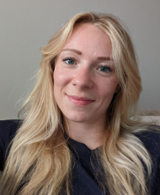Q&A with Adrienne Kline

What led you to join Northwestern as a postdoctoral fellow?
I am currently a postdoctoral fellow in the department of Preventative medicine and am co-supervised by Dr. Sanjiv Shah and Dr. Yuan Luo. I am supported by the NIH HeartShare research skills fellowship. I completed my PhD in biomedical engineering (with an imaging specialization in machine learning), an MD in medicine, both of which were preceded by a BSc in electrical engineering. My interests lie at the intersection of medicine and engineering, specifically in leveraging algorithmic decision-making support for translational applications to medicine. This has led to the development of novel methods for handling missing data, innovative metrics for evaluating the reliability of machine learning predictions, multimodal data fusion, reinforcement learning and generative algorithms. My hope is to affect both the efficiency and reliability with which medicine is practiced.
What projects have you been working on?
Here are a few projects I’ve worked on in the last year:
- Novel imputation method for categorical data
- Python-based propensity score matching package
- Reliability in machine learning estimates
- Medical image de-identification: Another project currently about to go out the door deals with image compression and medical image de-identification. It is a Python package designed to be as plug-and-play as possible for end users, called PyLogik. So, keep an eye out for this in the next couple of weeks if it might be of use to you!
What would people be surprised to learn about you?
People would probably be surprised to learn how broad my interests are. In addition to all the coding and math I do for work, I am always working and tinkering on projects and enjoy designing hardware (PCBs, mechatronics, and other mechanical solutions). Here is an example and tutorial of something I built in med school after receiving a ‘thank you’ Raspberry Pi for being a panelist at a symposium.
I always have a book in hand, and despite identifying as a ‘techie’, prefer hard copy books. One of my favorite places in Chicago is a used bookstore I frequent. The grad students will tell you I am competitive (mostly with myself) so enjoy rock climbing, running, beach volleyball, and beating them in squash. Our grad students will also tell you I love to teach, and to that end, I work as a science writer for several tech blogs. Lastly, I like to paint and draw, typically surreal artwork to decorate my own space. Having a ‘right brain’ hobby offers a therapeutic outlet that juxtaposes nicely with everything else!
Who inspires you?
Outside of my colleagues and very tenacious PIs, I am inspired by the father of information theory – Dr. Claude Shannon. He was both an electrical engineer (like me) and a mathematician to boot. I am inspired by him because unlike the Turing Award with which many people in the AI/ML space are familiar, his namesake award is far less known (Claude E. Shannon Award – IEEE) but has impacted the field of data science and informaticians whether they know it or not. If intrigued – check out Shannon’s mouse, designed all the way back in 1950.
What advice do you have for students who are deciding on a career path?
Regardless of career stage, I encourage people never to forego the fundamentals of math, statistics, computer science, and engineering. These fundamentals are the crux on which novelty is built. Everyone wants to implement the latest architecture, but oftentimes it is simple solutions brought together that are very powerful. Thomas Kuhn coined the notion of a ‘paradigm shift’ in his book The Structure of Scientific Revolutions. Often it is people new to the field or working at intersectional crossroads who can see things from a different perspective. So even if you arrive new to this field, don’t fret, you likely have something to contribute.
Returning to theory (the problem) is important, so context is huge. For me, this is how I leverage the MD training. Adaptability and malleability are an absolute necessity for staying current regardless of area, so never stop asking questions. Not understanding right now doesn’t mean you aren’t capable of understanding. Lastly, when devising a new machine learning project, I keep three major facets in mind – having a good research question, adequate support (training, teammates/personnel, mentorship), and the logistics (timing, funding etc.) required to execute it. New algorithms pop up daily, and if you focus on the leaves, you lose sight of the tree. Always ask yourself “so what?” to ground your work and as a reminder to answer the big questions.